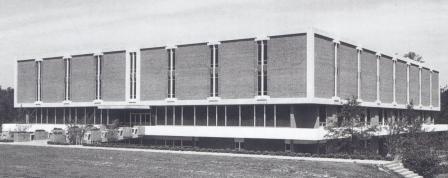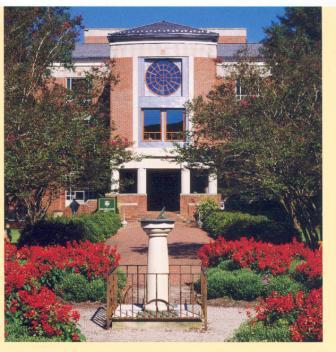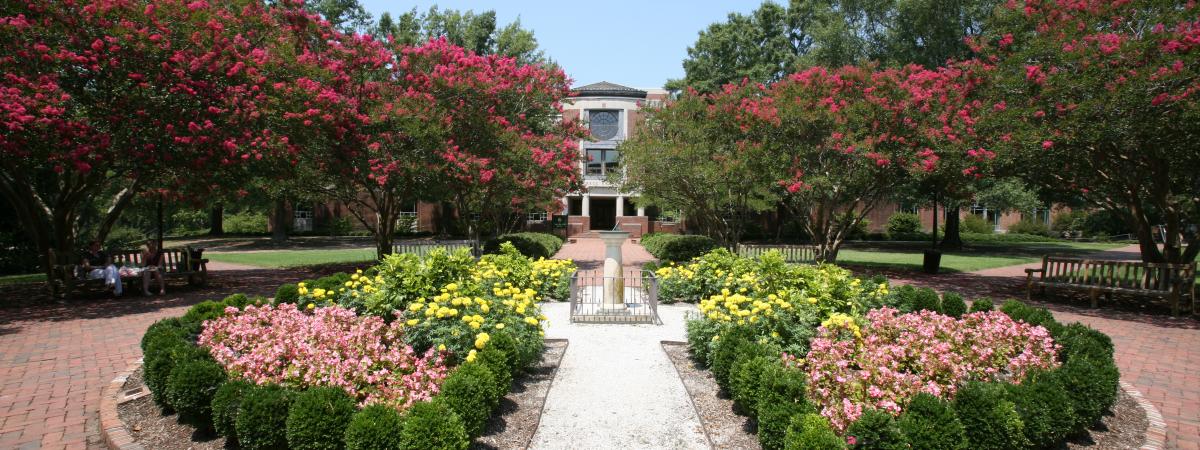The Earl Gregg Swem Library is located at 400 Landrum Drive (formerly Old Campus Drive), across new campus from Andrews Hall at William & Mary in Williamsburg, Virginia. William & Mary has been consistently ranked in the top 10 in the Princeton Review rankings of best college libraries in recent years.1 The library is named for Earl Gregg Swem (1870-1965), University Librarian (1920-1944) and Librarian Emeritus (1945-1965) (see the minutes of the Board of Visitors, May 11, 1963, p. 162-164). William & Mary's first building constructed to serve as a library was dedicated in 1909 and opened simply as the Library. The building is today known as Tucker Hall.

Renovations: 1986-1988, 1998-2005
Named for: Earl Gregg Swem
Map it
Abbreviated History of Swem Library
By Frederick P. Gibbs, Class of 1958, August 2007
When the Wren Building opened for business in 1697, somewhere on the second floor a nascent-library was evolving. The initial books were donations, at least several of them from the personal library of Francis Nicholson. This generous patronage from Virginia's governor inspired the donations from other prominent citizens and allowed the school to build its library without spending its capital. At first the library was "theological," as would befit an institution devoted to the training of clergy. In time would come books on history, travel, biography and commerce. By the end of the century a college official was overseeing this expanding collection of treasured volumes, all placed on shelves, all arranged according to size--.
--. and all incinerated in a fire that ravaged the Wren in the fall of 1705. With funds from Queen Anne a new building was completed by 1716 and, to encourage local citizens to help replenish the rebuilt library with donations of their own, the library went public by extending its services to the neighboring residents.
With the death of founding president James Blair in 1743 the dominant "theological" tone of the library yielded to an escalation of classics as Blair's successor, William Dawson, began staffing the faculty with former colleagues of Queen's College, Oxford. This change in the library's composition was soon followed by the range of scientific curiosity shortly before the earliest rumblings of revolution were heard. "Electricity" was all the rage then, as were the physics lectures of William Small and the recent publications by the men of science. As the library added the category of natural sciences, the university in 1761 appointed its first official librarian.
Surviving the Revolution and left remarkably unscathed, except for the theft of volumes by troops from both sides, by war's end the nearly 3,000 books in the university library made it the second largest of its kind in North America, after Harvard. As William & Mary approached its centennial in 1793, donations from the country's former ally France added another thousand volumes. Official regulations for use of the library were posted: students were to pay ten shillings a year for use of the facility; and after leaving a deposit equal to the book's value, could borrow only one book at a time between 9 and 10 on Monday and Friday mornings, and would forfeit the deposit if the book was damaged, or replace it if lost.
From the earliest days of the university to the close of the 19th century when a collection of 6,000 books was available only two hours a day to faculty and a student body shy of 200, and when Blanche Moncure, tapped librarian in 1899, became the university's first female administrative officer, the library remained in the Wren, which fires victimized in 1859 and 1862. In the dawn of the next century, during the lengthy presidency of Lyon Gardiner Tyler, a 30' by 80' brick edifice (where Tucker Hall now stands) was built to accommodate a burgeoning library. By 1919 the one-story structure contained a collection of 18,000 volumes. That year welcomed the presidency of Julian A. C. Chandler and an era of campus construction - Blow Gymnasium, Phi Beta Kappa Hall, Rogers and Washington, dormitories for men and coeds, and an expansion of the library from one story to three.
Enter Earl Gregg Swem
As President Chandler observed the upward and outward enlargement of Tucker Hall to provide adequate space for the steady influx of new books, he realized the necessity of hiring a professional to manage and develop a library that in a few decades would rank commendably among Southern colleges.
Born in Iowa in 1870 and the recipient of both a Bachelor's and Master's degree from Lafayette University, Earl Gregg Swem had been associated with the Library of Congress and the Virginia State Library and was a recognized bibliographer of manuscripts and historical records before he arrived on campus in 1920. During his 25-year tenure as university librarian, Swem saw the quantity of books increase from 25,000 to more than 240,000, established the Archives and Manuscript Department, opened the stacks to both students and the public, taught classes in library science and edited the William & Mary Quarterly. He retired on July 1, 1944, and died in 1965 at the age of 94.
By the early 1950s concern mounted about the threatening inadequacies of the library. A 1959 plan to replace Tucker Hall with a larger facility at the western end of the Sunken Garden was abandoned. With the new administration of Davis Y. Paschall in 1961 came the development of a new campus west of the existing one. During Homecoming Weekend 1963 a groundbreaking ceremony prepared the way for the new 136,000-square-foot library which William & Mary's Board of Visitors chose to name for Dr. Swem. The doors officially opened January 4, 1966.
By the 1980s, the need for additional shelving resulted in an addition added to all four floors of the front of the building. A decade later, there were critical space needs for Special Collections, computers, and group study rooms. In 1998, ground was broken for two three-story pavilions which were added to the east side of the library. The larger pavilion features a spacious reading room on the first floor and compact shelving throughout; the smaller houses special collections, rare books, the university archives, and the papers and memorabilia of Chief Justice Warren E. Burger. As it presently stands, the Early Gregg Swem Library was rededicated on Charter Day, 2005.
Bibliography
- "The Library of the College of William & Mary in Virginia, 1693-1793," by John M. Jennings
- "Swem Library History," an oral presentation by Susan Riggs
Construction
Detailed discussions of plans for the library were held in 1963 (Minutes of the Board of Visitors, January 5, 1963, p. 84-92; March 23, 1963, p. 135-138) and the groundbreaking ceremonies were held later that year on October 11, 1963, at Phi Beta Kappa Hall. The actual groundbreaking occurred a few weeks after the ceremonies. (The Flat Hat, 11 January 1963, 1) The cornerstone of the library was laid on October 22, 1964, and the building was scheduled for completion around December 1965. (The Flat Hat, 17 September 1965, 4) The building officially opened on January 4, 1966, although it was not fully complete. (The Flat Hat, 14 January 1966, 1) The official dedication ceremony for the library was held on Charter Day, February 12, 1966. The Tucker-Coleman Room of the library was dedicated on November 11, 1966. (Minutes of the Board of Visitors, January 14, 1967, 320; The Flat Hat, 11 November 1966, 1)
At the time of its completion, the ground floor of Swem Library contained the Botetourt Gallery, an auditorium, the Institute of Early American History and Culture offices, a rare book room, an honors room, a museum, an audio/visual department, a film preview room, and a faculty lounge. The first floor contained a reserve room, an after-hours reading room, a reference department, and typing and meeting rooms. The second floor contained administration rooms, conference rooms, and stacks. The dedication for the Botetourt Theater read: "Botetourt Auditorium - In memory of J.A.C. Chandler, 18th President of the College - by Chancellor and Mrs. A.D. Chandler." ('Botetourt Gallery and Theater," Swem Library Subject Files)
Fire
A fire in the Botetourt Theater in 1972 destroyed a projection booth. (The Flat Hat, 12 May 1972, 1.)
Additions and Renovations
A Micro Computer Lab opened in the library on February 13, 1984. (William & Mary News, 24 January 1984, 5)
1986-1988
Construction officially began on an addition to the front of the library on March 3, 1986, to provide extra stack space, reading areas, administrative offices, and a 24-hour study room and snack area. O.K. James Construction Co. led construction.1 The addition was dedicated on February 5, 1988.
1998-2005

Renovations: 1986-1988, 1998-2005
Map it
A seven-year renovation was officially completed in 2005 with re-dedication ceremonies officially marking the completion on February 5, 2005, during the university's Charter Day weekend. See also the Swem Library Building Project online exhibit.
Construction timeline:
- October 16, 1992: Inauguration of Tim

